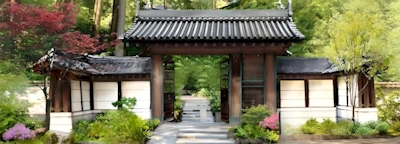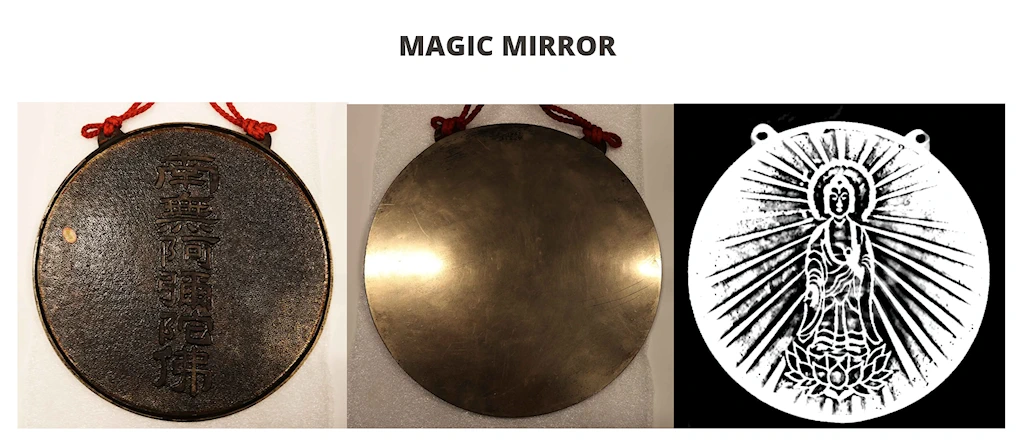2024 Very Rare Japan Magic Mirror Discovery From the Edo and Meiji Periods at Putnam Museum (Video Background) When Light Reflected, Image of BuddhaNEW
Other Events At This Location
Putnam Museum
This Specific Event Date Has Passed
Davenport, IA 52804
Brand New Discovery at the Putnam Museum and Science Center. “Magic Mirror” rediscovered within the Putnam collection after over 100 years in storage.
DAVENPORT, Iowa (February 25, 2024) - The Putnam Museum and Science Center unveiled an amazing discovery at the fundraising gala Mysteries at the Museum last night. For over 100 years the Putnam has had a “Magic Mirror” from Japan sitting in collections without realizing it. Nora Moriarty and the Putnam curatorial team discovered the mirror in 2022 and after a lengthy authentication process, the museum is ready to bring the mirror to the public.
The magic mirror is a bronze mirror that is engraved on the back in Chinese characters reading “Homage to Amitābha [Buddha]”. But what is so special about this mirror is that when light hits it at just the right angle, an image that would otherwise be completely hidden to the naked eye is projected onto the wall. These mirrors were popular in Japan during the Edo and Meiji periods, and are exceedingly rare as they were difficult to make and possibly expensive to purchase. As of today we know of only three of this type of incredible mirror in the United States: this mirror, one at the Cincinnati Art Museum, and one at the Metropolitan Museum of Art.
“This is a significant find not only for the Putnam Museum, but for the world as well” shared Nora Moriarty Curatorial Project Coordinator. “There are very few of these mirrors currently identified, and a new addition like ours may help scholars learn about where and when they were created.” This mirror was purchased in 1904 in Japan by Charles Ficke who brought it back to his home town of Davenport and later included it in a large donation to the Putnam Museum. In his records, Ficke lists this mirror as a “Magic Mirror” but over time that knowledge was lost to the Putnam Museum records until one Friday afternoon when Nora Moriarty began to become curious about the bronze mirrors in the Putnam collection after reading about one recently discovered at the Cincinnati Art Museum. After some trial and error with a flashlight, the team saw evidence that this mirror might truly be magic. With the help of Genesis Health System the museum was able to perform a CT scan on the mirror so that they could see the layers inside. What was found was an amazing image of Amitābha Buddha between the layers of the mirror that can only be seen under perfect lighting conditions.
“It was an exciting moment, illuminating the mirror in the darkness with a flashlight. I thought I saw the image of a buddha that day, but I wasn’t sure. Seeing my suspicions confirmed in that CT scan was beyond exciting. I knew then that we truly had something special here at the Putnam Museum” shared Nora. The Magic Mirror will be on temporary display beginning Tuesday February 27 for a limited time at the Putnam. It will eventually be moved to a permanent display during a separate project at the museum connected to the capital campaign. Interested parties can visit the Putnam’s website to find out more about the specifics of the mirror.
Exhibition Dates
On temporary display beginning Tuesday February 27, 2024
Time
10:00 am - 5:00 pm
Tickets
Who made it?
We don’t know exactly who the artisan was, but they would have been a skilled metalworker.
When was it made?
Most likely the latter half of the 19th century CE during the Meiji Period. It could also have been made during the late Edo Period.
Why is it called a “Magic Mirror”?
This type of bronze mirror is called magic because when the light is reflected off of its polished surface onto a flat, white surface, it reflects an image which is otherwise invisible to the naked eye. What seems to be a blank polished surface is able to reflect a detailed image - in this case, an image of Buddha.
How did it get to the Putnam Museum in Davenport?
The mirror was purchased in 1904 by C.A. Ficke during a trip to Japan. he doesn’t tell us what town he purchased it in, just that it came from Japan. In his ledger he describes it as “very old”, but in all likelihood it was only a few decades old at the time.
How does it work?
The mirror’s magic properties are a result of careful craftsmanship. The bronze mirror is made up of two plates sandwiched together. The ‘back’ plate has the visible Chinese inscription “Amitabha Buddha”, and the front plate, hidden between the layers of bronze, is an image of Buddha. When the artist created this plate, they compressed the lines of the Buddha into the bronze, which pushed through to the visible polished surface. One cannot see where the design pushes through, it is a microscopic variation in the bronze, but it is enough of a change in the atoms of the metal that it affects how the light reflects off the surface.
What does “Amitabha Buddha” mean?
Amitabha Buddha is an important buddha in Pure land Buddhism. He is believed to have once been a monk named Dharmakara. He believed that by living according to 48 tenets, he may reach or be reborn into the realm buddhaksetra, or Pure land/Buddha Land. There are some that believe that he lived many lives of great merit and created his own Pure Land called Sukhavati, which his followers may attain themselves.
How many of these mirrors are there?
We’re not sure! Lots of mirrors like this one are probably in museums and private collections all over the world without people realizing what they are. Recently a researcher named Janet Leigh Foster shared that she had counted 24 double-plated bronze mirrors worldwide, and only a handful of them are known to be in the United States. This includes the Cincinnati Art Museum, the Metropolitan Museum of Art, and now the Putnam Museum and Science Center.
This mirror seems very similar to the Cincinnati Art Museum mirror.
It certainly is! Dr. Hou-mei Sung (CAM Curator of East Asian Art) agrees that our two mirrors seem to be the same type. It may be that they were produced in the same workshop, maybe by the same artist, perhaps cast from the same mold. We’re excited to learn more by comparing the mirrors. Another very similar mirror is in the Kamakura Museum in Japan.
Thanks
Thank you to Jordan Voigt, Brandi Eriksen, Vanessa Fowler of Genesis Health System for donating their time and equipment to help authenticate this discovery. Special thanks to Dr. Hou-Mei Sung and Kelly Rectenwald of the Cincinnati Art Museum, and Janet Leigh Foster of the University of London for sharing their expertise.
Major general operating support is provided to the Putnam by the City of Davenport; Quad Cities Cultural Trust; Putnam Power Circle Members; the Iowa Arts Council, which exists within the Iowa Economic Development Authority; and Birdies for Charity.
Disclaimer: Please double check all information provided on our platform with the official website for complete accuracy and up-to-date details.
Friday, 12 July, 2024
Event Contact
Magic Mirror - Putnam MuseumPhone: (563) 324-1933
Event Organizer Website
Visit Organizer Website
Get More Details From the Event Organizer
Event Location Website
Visit Location Website
For More Location Details
Event Information Can Change
Always verify event information for possible changes or mistakes.Contact Us for Issues

















